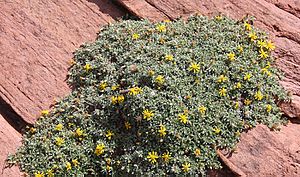Jones's goldenaster facts for kids
Quick facts for kids Jones's goldenaster |
|
|---|---|
 |
|
| Heterotheca jonesii in Zion National Park | |
| Scientific classification | |
| Kingdom: | |
| (unranked): | |
| (unranked): | |
| (unranked): | |
| Order: | |
| Family: | |
| Tribe: |
Astereae
|
| Genus: |
Heterotheca
|
| Species: |
H. jonesii
|
| Binomial name | |
| Heterotheca jonesii (S.F.Blake) S.L.Welsh & N.D.Atwood 1976
|
|
| Synonyms | |
|
|
Heterotheca jonesii, also known as Jones's goldenaster, is a special kind of flowering plant. It is quite rare and belongs to the aster family, which includes plants like sunflowers and daisies. You can only find this plant growing in the southern part of Utah in the United States.
Contents
What is Jones's Goldenaster?
Jones's goldenaster is a small plant that produces bright, golden-yellow flowers. These flowers look a lot like tiny daisies or sunflowers. The plant gets its common name, "goldenaster," because of its pretty golden blooms. It was first described in 1895.
Appearance of the Plant
The plant usually grows close to the ground. Its leaves are often covered in fine hairs. This helps the plant survive in dry places. The golden flowers are the most noticeable part. They typically bloom in late summer or early fall. Each flower head is actually made up of many tiny flowers.
Its Family: Asteraceae
Heterotheca jonesii is part of the Asteraceae family. This is one of the largest plant families in the world. Plants in this family often have flower heads that look like a single flower. But they are really a cluster of many small flowers. Think of a sunflower: the center is full of tiny disk flowers. The petals around the edge are ray flowers.
Where Does Jones's Goldenaster Grow?
This rare plant has a very specific home. It lives only in southern Utah. This area is known for its unique landscapes. It has deserts, canyons, and rocky cliffs.
Preferred Habitat
Jones's goldenaster likes to grow in dry, rocky places. It can often be found on slopes or in sandy soils. These areas get a lot of sunshine. The plant is adapted to living where water is scarce. Its roots can reach deep into the ground. This helps it find moisture.
Why It's Rare
A plant is called "rare" when there are not many of them left. Jones's goldenaster is rare because it only grows in a small area. It also needs very specific conditions to thrive. Changes to its habitat can make it even harder for the plant to survive. Scientists work to protect rare plants like this one. They want to make sure these unique species don't disappear forever.
Life Cycle of Jones's Goldenaster
Like all flowering plants, Jones's goldenaster goes through a life cycle. It starts from a seed and grows into a mature plant. Then it produces its own seeds.
Reproduction
The golden flowers of Heterotheca jonesii are important for reproduction. They attract insects like bees. These insects help carry pollen from one flower to another. This process is called pollination. After pollination, the flowers produce seeds. These seeds will then grow into new plants.
Surviving in the Desert
The plant has special ways to survive in its dry home. It might have thick leaves to store water. Or it might have a deep root system. These adaptations help it live through hot, dry summers. They also help it grow in poor soils.

